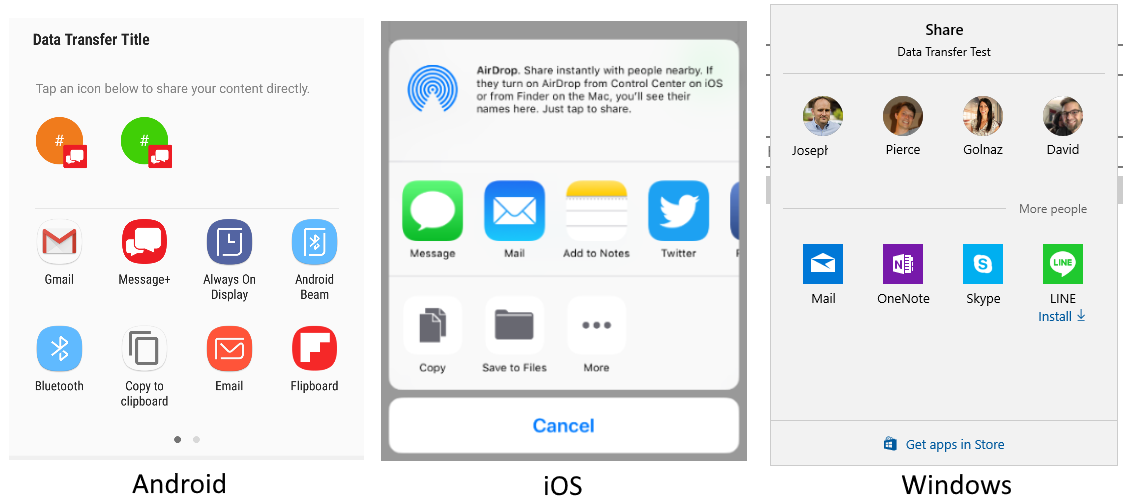Share
This article describes how you can use the .NET Multi-platform App UI (.NET MAUI) IShare interface. This interface provides an API to send data, such as text or web links, to the devices share function.
The default implementation of the IShare interface is available through the Share.Default property. Both the IShare interface and Share class are contained in the Microsoft.Maui.ApplicationModel.DataTransfer namespace.
When a share request is made, the device displays a share window, prompting the user to choose an app to share with:

Get started
To access the Share functionality, the following platform-specific setup is required:
No setup is required.
Share text and links
The share functionality works by calling the RequestAsync method with a data payload that includes information to share to other applications. ShareTextRequest.Text and ShareTextRequest.Uri can be mixed and each platform will handle filtering based on content.
public async Task ShareText(string text)
{
await Share.Default.RequestAsync(new ShareTextRequest
{
Text = text,
Title = "Share Text"
});
}
public async Task ShareUri(string uri, IShare share)
{
await share.RequestAsync(new ShareTextRequest
{
Uri = uri,
Title = "Share Web Link"
});
}
Share a file
You can also share files to other applications on the device. .NET MAUI automatically detects the file type (MIME) and requests a share. However, operating systems may restrict which types of files can be shared. To share a single file, use the ShareFileRequest type.
The following code example writes a text file to the device, and then requests to share it:
public async Task ShareFile()
{
string fn = "Attachment.txt";
string file = Path.Combine(FileSystem.CacheDirectory, fn);
File.WriteAllText(file, "Hello World");
await Share.Default.RequestAsync(new ShareFileRequest
{
Title = "Share text file",
File = new ShareFile(file)
});
}
Share multiple files
Sharing multiple files is slightly different from sharing a single file. To share a single file, use the ShareMultipleFilesRequest type.
The following code example writes two text files to the device, and then requests to share them:
public async Task ShareMultipleFiles()
{
string file1 = Path.Combine(FileSystem.CacheDirectory, "Attachment1.txt");
string file2 = Path.Combine(FileSystem.CacheDirectory, "Attachment2.txt");
File.WriteAllText(file1, "Content 1");
File.WriteAllText(file2, "Content 2");
await Share.Default.RequestAsync(new ShareMultipleFilesRequest
{
Title = "Share multiple files",
Files = new List<ShareFile> { new ShareFile(file1), new ShareFile(file2) }
});
}
Presentation location
Important
This section only applies to iPadOS.
When requesting a share or opening launcher on iPadOS, you can present it in a popover. This specifies where the popover will appear and point an arrow directly to. This location is often the control that launched the action. You can specify the location using the PresentationSourceBounds property:
await Share.RequestAsync(new ShareFileRequest
{
Title = Title,
File = new ShareFile(file),
PresentationSourceBounds = DeviceInfo.Platform == DevicePlatform.iOS && DeviceInfo.Idiom == DeviceIdiom.Tablet
? new Rect(0, 20, 0, 0)
: Rect.Zero
});
await Launcher.OpenAsync(new OpenFileRequest
{
File = new ReadOnlyFile(file),
PresentationSourceBounds = DeviceInfo.Platform == DevicePlatform.iOS && DeviceInfo.Idiom == DeviceIdiom.Tablet
? new Rect(0, 20, 0, 0)
: Rect.Zero
});
Everything described here works equally for Share and Launcher.
Here is an extension method that helps calculate the bounds of a view:
public static class ViewHelpers
{
public static Rect GetAbsoluteBounds(this Microsoft.Maui.Controls.View element)
{
Element looper = element;
var absoluteX = element.X + element.Margin.Top;
var absoluteY = element.Y + element.Margin.Left;
// Add logic to handle titles, headers, or other non-view bars
while (looper.Parent != null)
{
looper = looper.Parent;
if (looper is Microsoft.Maui.Controls.View v)
{
absoluteX += v.X + v.Margin.Top;
absoluteY += v.Y + v.Margin.Left;
}
}
return new Rect(absoluteX, absoluteY, element.Width, element.Height);
}
}
This can then be used when calling RequestAsync:
public Command<Microsoft.Maui.Controls.View> ShareCommand { get; } = new Command<Microsoft.Maui.Controls.View>(Share);
async void Share(Microsoft.Maui.Controls.View element)
{
try
{
await Share.Default.RequestAsync(new ShareTextRequest
{
PresentationSourceBounds = element.GetAbsoluteBounds(),
Title = "Title",
Text = "Text"
});
}
catch (Exception)
{
// Handle exception that share failed
}
}
You can pass in the calling element when the Command is triggered:
<Button Text="Share"
Command="{Binding ShareWithFriendsCommand}"
CommandParameter="{Binding Source={RelativeSource Self}}"/>
For an example of the ViewHelpers class, see the .NET MAUI Sample hosted on GitHub.
Platform differences
This section describes the platform-specific differences with the share API.
- The ShareTextRequest.Subject property is used for the desired subject of a message.
 Browse the sample
Browse the sample